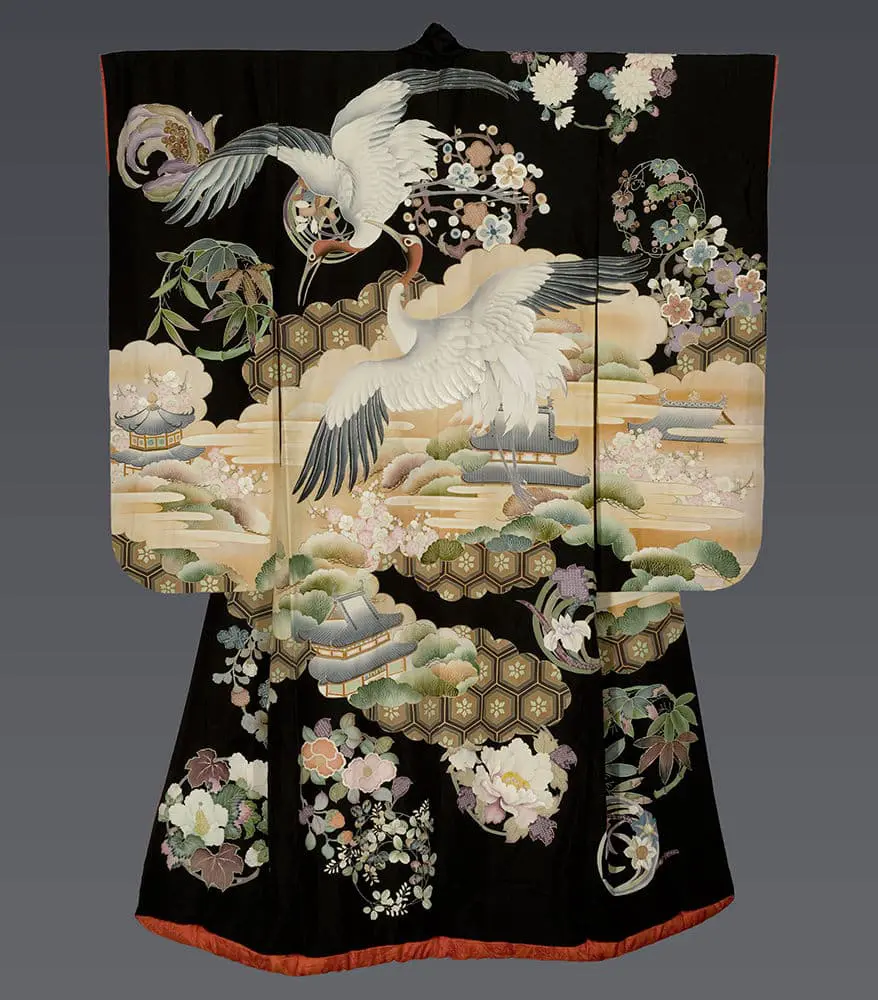This exquisite silk uchikake carries profound ceremonial significance, with its luxurious silk foundation providing the perfect canvas for an elaborate paradise scene rich with auspicious wedding symbolism.
The technical achievement of this piece is extraordinary, particularly in its seamless design continuity across the entire garment. Traditional kimono construction requires cutting and sewing four separate fabric panels (the front panels, back panel, and sleeves), which typically creates interruptions in decorative schemes at the seam lines. Here, the artisan has achieved the rare feat of creating a completely uninterrupted narrative that flows organically from panel to panel, requiring precise planning and execution during both the design phase and the complex yuzen dyeing process. This technical mastery is further enhanced by the sophisticated layering of decorative techniques: the foundational yuzen painting provides the base imagery, while metallic couching creates raised linear elements that define key motifs like the kikko patterns, and gold thread embroidery adds textural richness. Brush-painted highlights applied over the dyed areas create subtle gradations and dimensional modeling, particularly visible in the crane feathers and floral elements.
The design layout demonstrates sophisticated compositional understanding, with the two magnificent white cranes positioned as the primary focal point across the upper back and shoulders, their dynamic flight patterns creating visual movement that draws the eye upward. These cranes carry deep wedding significance - in Japanese tradition, cranes mate for life and symbolize marital fidelity, longevity, and good fortune, making them the most auspicious motif for bridal garments. The cranes' positioning takes advantage of the uchikake's trailing silhouette, with decorative elements cascading downward in asymmetrical balance. The traditional kikko (tortoiseshell hexagonal) motifs scattered throughout represent longevity and protection, their geometric forms adding structural harmony while symbolizing the enduring strength of marriage bonds. The abundant floral garlands, featuring cherry blossoms and seasonal blooms, celebrate fertility, renewal, and the beauty of life's cycles, while their continuous flowing arrangement suggests the unbroken continuity of family lineage.
The overall aesthetic evokes the Rinpa school's decorative approach, with its bold compositional arrangements and stylized natural forms set against the dramatic black silk ground. The paradise imagery, complete with flowering branches, geometric cloud patterns, and the celestial cranes, reflects both Buddhist and Shinto influences, creating an uchikake that functions as both wearable art and spiritual blessing. The dramatic black ground serves not merely as negative space but as an active compositional element that allows the paradise imagery to float ethereally, creating depth while emphasizing the symbolic separation between earthly and heavenly realms - transforming this garment into a sacred vestment that invokes divine protection and celestial blessings for the bride's new journey in marriage.
Measurements: 49 inches (124 cm) from sleeve-end to sleeve-end and standing at a height of 66 inches (168 cm)
This artwork is featured on pages 338-341 of Ceremonial Textiles of Japan, 18th to 20th Centuries. This book, published by Yorke Antique Textiles, can be previewed or purchased on our website here.
This piece also featured on page 135 of the January-February 2018 edition of Arts of Asia.
.avif)

















